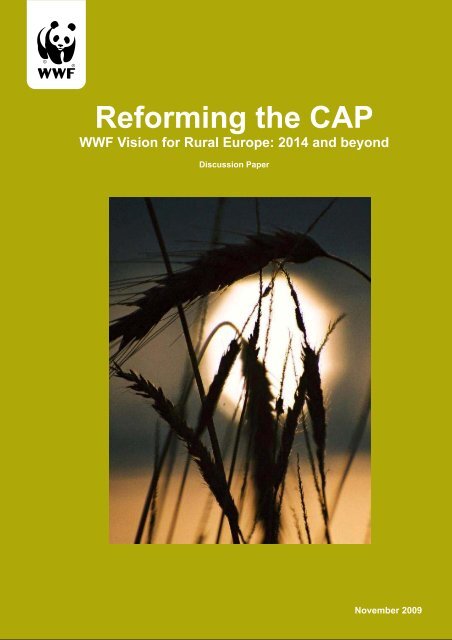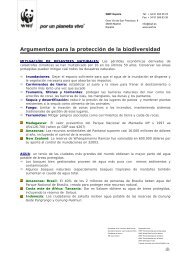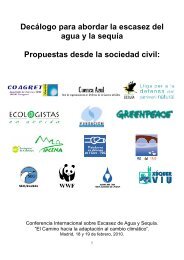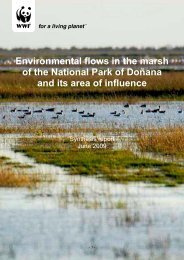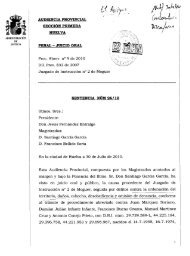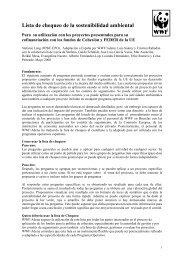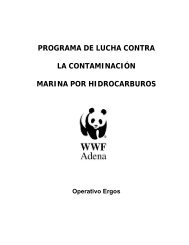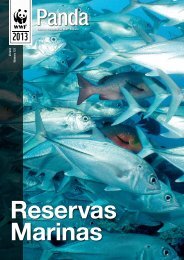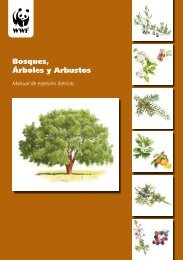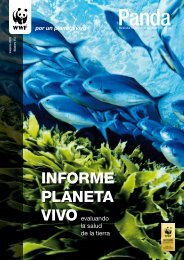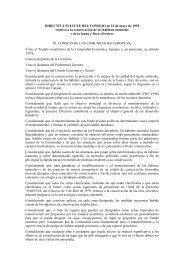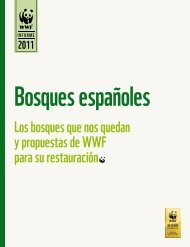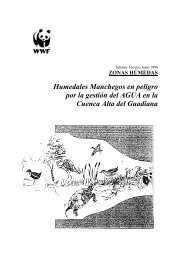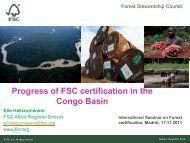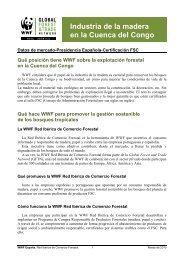Reforming the CAP WWF Vision for Rural Europe after 2013
Reforming the CAP WWF Vision for Rural Europe after 2013
Reforming the CAP WWF Vision for Rural Europe after 2013
You also want an ePaper? Increase the reach of your titles
YUMPU automatically turns print PDFs into web optimized ePapers that Google loves.
<strong>Re<strong>for</strong>ming</strong> <strong>the</strong> <strong>CAP</strong><br />
<strong>WWF</strong> <strong>Vision</strong> <strong>for</strong> <strong>Rural</strong> <strong>Europe</strong>: 2014 and beyond<br />
Discussion Paper<br />
November 2009 1
“The challenge now is to address <strong>the</strong> legacy of past<br />
environmental damage and shape <strong>the</strong> <strong>CAP</strong> into a<br />
policy which can deliver sustainable agriculture<br />
throughout <strong>the</strong> EU by establishing a new contract<br />
between land managers and society. How to achieve<br />
this is <strong>the</strong> focus of this vision paper."<br />
2
World Wide Fund <strong>for</strong> Nature (<strong>WWF</strong>)<br />
<strong>WWF</strong> is one of <strong>the</strong> world’s largest and most experienced independent conservation organisations, with almost<br />
five million members and supporters and a global network active in some 100 countries. At <strong>Europe</strong>an level,<br />
<strong>WWF</strong> is present in 19 of <strong>the</strong> 27 EU member states. <strong>WWF</strong>´s embassy to <strong>the</strong> <strong>Europe</strong>an Union is in <strong>the</strong> Brusselsbased<br />
<strong>Europe</strong>an Policy Office (EPO).<br />
<strong>WWF</strong>’s mission is to stop <strong>the</strong> degradation of <strong>the</strong> planet’s natural environment to build a future in which humans<br />
live in harmony with nature, by:<br />
• conserving <strong>the</strong> world’s biological diversity<br />
• ensuring that <strong>the</strong> use of renewable natural resources is sustainable<br />
• promoting <strong>the</strong> reduction of pollution and wasteful consumption.<br />
<strong>WWF</strong> <strong>Vision</strong> <strong>for</strong> <strong>Rural</strong> <strong>Europe</strong>: 2014 and beyond<br />
With this <strong>Vision</strong> <strong>for</strong> a future Common Agriculture Policy (<strong>CAP</strong>), <strong>WWF</strong> proposes radical changes. This new vision<br />
is based on <strong>the</strong> principle of “public payments <strong>for</strong> public goods” and on <strong>the</strong> need to financially support <strong>the</strong> land<br />
managers who produce public goods <strong>for</strong> <strong>the</strong> benefit of society as a whole.<br />
<strong>WWF</strong> believes that farmers and environmentalists must now work toge<strong>the</strong>r to safeguard <strong>the</strong> future of <strong>Europe</strong>an<br />
agriculture and natural resources.<br />
This vision was developed and written by <strong>WWF</strong> staff and Vicki Swales, an independent rural policy consultant.<br />
Please contact <strong>the</strong> members of <strong>the</strong> <strong>WWF</strong> Team on <strong>Europe</strong>an Agriculture <strong>for</strong> more in<strong>for</strong>mation. You can find<br />
details on <strong>the</strong> back page of this document.<br />
Published November 2009 by <strong>WWF</strong>, World Wide Fund <strong>for</strong> Nature (<strong>for</strong>merly World Wildlife Fund), Brussels,<br />
Belgium. Any reproduction in full or in part of this publication must mention <strong>the</strong> title and credit <strong>the</strong> abovementioned<br />
publisher as <strong>the</strong> copyright owner. © text 2009, <strong>WWF</strong>. All rights reserved.<br />
Photo frontpage: © Łukasz Adamski / <strong>WWF</strong><br />
Printed on recycled paper<br />
3
TABLE OF CONTENTS<br />
EXECUTIVE SUMMARY 5<br />
PART I: WHY <strong>CAP</strong> REFORM IS NEEDED 7<br />
Introduction 7<br />
1. A chance <strong>for</strong> change – The EU Budget Review 7<br />
2. Agriculture and <strong>the</strong> environment 8<br />
3. <strong>CAP</strong>’s responsibilities and future challenge 9<br />
4. The <strong>CAP</strong>: a pre-eminent policy 9<br />
5. Why fur<strong>the</strong>r <strong>CAP</strong> re<strong>for</strong>m is needed 11<br />
5.1 Arguments <strong>for</strong> <strong>CAP</strong> re<strong>for</strong>m 11<br />
5.2 Food Security, market regulation: arguments against <strong>CAP</strong> re<strong>for</strong>m 11<br />
PART II: TRANSFORMING THE <strong>CAP</strong> INTO A COMMON ENVIRONMENT AND<br />
RURAL POLICY, FOR THE BENEFIT OF SOCIETY AS A WHOLE 13<br />
6. Is <strong>the</strong>re a need <strong>for</strong> public support <strong>for</strong> farming 13<br />
6.1 Is <strong>the</strong>re a need <strong>for</strong> a ‘common’ rural policy 13<br />
7. Principles <strong>for</strong> a new rural policy 13<br />
8. A Common Environment and <strong>Rural</strong> Policy (CERP) 14<br />
9. Balance of expenditure 17<br />
10. A period of transition 17<br />
11. Benefits of a Common Environment and <strong>Rural</strong> Policy 19<br />
12. Action <strong>for</strong> change 19<br />
4
<strong>Re<strong>for</strong>ming</strong> <strong>the</strong> <strong>CAP</strong><br />
<strong>WWF</strong> <strong>Vision</strong> <strong>for</strong> <strong>Rural</strong> <strong>Europe</strong>: 2014 and beyond<br />
Executive Summary<br />
Sustainable agriculture is of fundamental importance to mankind, producing not only food and fibre but<br />
also, through its interaction with land and natural resources, per<strong>for</strong>ming vital functions such as nutrient<br />
cycling and carbon storage. For much of <strong>Europe</strong>’s history, farming was small-scale, subsistent in nature<br />
and sympa<strong>the</strong>tic to <strong>the</strong> natural environment. Indeed, traditional, low input <strong>for</strong>ms of agriculture have helped<br />
to create <strong>the</strong> variety of landscapes and associated wildlife that are highly valued by <strong>Europe</strong>an citizens<br />
today. But with population growth, <strong>the</strong> introduction of new technology and encouraged by public policy,<br />
agriculture has become increasingly intensive and industrialised over <strong>the</strong> last fifty years or more. The loss<br />
and degradation of habitats, declines in wildlife, over-abstraction of water <strong>for</strong> irrigation, soil erosion and<br />
water pollution are just some of <strong>the</strong> problems we now face as a result of modern agriculture. Climate<br />
change brings a considerable new challenge; it accounts <strong>for</strong> 9% of EU greenhouse gas (GHG) emissions<br />
mostly due to stockbreeding and inappropriate utilization of syn<strong>the</strong>tic nitrogen fertilizers. Agriculture will<br />
need to adapt to a changing climate but could also offer some solutions. Setting agriculture on a more<br />
sustainable footing is a challenge <strong>for</strong> all of us at <strong>the</strong> beginning of <strong>the</strong> 21 st century.<br />
<strong>WWF</strong> believes that farmers and environmentalists must work toge<strong>the</strong>r to safeguard <strong>the</strong> future of<br />
<strong>Europe</strong>an agriculture and environment. Only by taking steps to ensure <strong>the</strong> long-term, sustainable<br />
management of natural resources on which agriculture relies, can o<strong>the</strong>r current concerns such as food<br />
security be addressed.<br />
Agriculture policy has a major role to play in achieving a truly sustainable agriculture. Successive<br />
re<strong>for</strong>ms of <strong>the</strong> Common Agricultural Policy (<strong>CAP</strong>) have started <strong>the</strong> process of encouraging more<br />
sustainable <strong>for</strong>ms of agriculture but much remains to be done. It is now critical to consider what fur<strong>the</strong>r<br />
progressive changes are needed in agriculture policy over <strong>the</strong> coming decade or more.<br />
In this paper, <strong>WWF</strong> outlines its ‘<strong>Vision</strong> <strong>for</strong> a new Common Environment and <strong>Rural</strong> Policy (CERP)’ to<br />
replace <strong>the</strong> old and increasingly outdated <strong>CAP</strong>. CERP is based on <strong>the</strong> principle of ‘public payments<br />
<strong>for</strong> public goods’ - such as carbon storage with permanent pastures, <strong>the</strong> maintenance of biodiversity<br />
and landscapes, <strong>the</strong> protection of soil and water resources and <strong>the</strong> development of vibrant rural areas. It<br />
recognises <strong>the</strong> need to financially support those land managers who produce <strong>the</strong>se goods <strong>for</strong> <strong>the</strong> benefit<br />
of society as a whole.<br />
5
The benefits of shifting from <strong>CAP</strong> to CERP are manifold:<br />
• Achieve sustainable land management, addressing <strong>the</strong> many environmental challenges facing<br />
rural <strong>Europe</strong> including <strong>the</strong> need <strong>for</strong> better water management, reversing declines in biodiversity<br />
and climate change adaptation and mitigation;<br />
• Establish a new contract between land managers and society, recognising <strong>the</strong> vital role <strong>the</strong>y play in<br />
<strong>the</strong> provision of environmental goods and services;<br />
• Keep rural areas alive by supporting environmentally sustainable rural development, helping to<br />
boost jobs and <strong>the</strong> rural economy in ways that also deliver environmental benefits;<br />
• Offer a long-term safeguard of supplementary income <strong>for</strong> farmers, based on <strong>the</strong> delivery of public<br />
goods, additional to <strong>the</strong> fluctuating returns from <strong>the</strong> sale of agricultural products;<br />
• Offer a much more transparent, coherent and efficient use of taxpayers´ money.<br />
• Contribute to restore <strong>the</strong> confidence of consumers in farm products by enabling <strong>the</strong> provision of<br />
healthy food originating from healthier ecosystems<br />
<strong>WWF</strong> argues that steps must be taken now to make this <strong>Vision</strong> a reality and calls on <strong>Europe</strong>an and<br />
national decision makers to:<br />
• make full use of existing <strong>CAP</strong> measures to achieve better management of land and water<br />
resources, reverse <strong>the</strong> decline in biodiversity and adapt to, and mitigate against, climate change;<br />
• engage in a full and open debate about <strong>the</strong> future of <strong>the</strong> EU budget and <strong>the</strong> need <strong>for</strong> substantive<br />
re<strong>for</strong>m of <strong>the</strong> <strong>CAP</strong> to create a new fund focused on sustainable land management and rural<br />
development;<br />
• work in partnership with environmental NGOs, farmers’ representatives, academics and o<strong>the</strong>rs to<br />
develop a new Common Environment and <strong>Rural</strong> Policy <strong>for</strong> implementation in 2019.<br />
The time <strong>for</strong> change is now. <strong>Europe</strong>’s decision makers have a responsibility to citizens, consumers and<br />
taxpayers to address <strong>the</strong> many environmental problems of <strong>the</strong> past and <strong>for</strong>ge a new and sustainable future<br />
<strong>for</strong> <strong>Europe</strong>’s rural areas.
<strong>Re<strong>for</strong>ming</strong> <strong>the</strong> <strong>CAP</strong><br />
<strong>Re<strong>for</strong>ming</strong> <strong>the</strong> <strong>CAP</strong><br />
<strong>WWF</strong> <strong>Vision</strong> <strong>for</strong> <strong>Rural</strong> <strong>Europe</strong>: 2014 and beyond<br />
<strong>WWF</strong> <strong>Vision</strong> <strong>for</strong> <strong>Rural</strong> <strong>Europe</strong> <strong>after</strong> <strong>2013</strong><br />
Part I: Why <strong>CAP</strong> re<strong>for</strong>m is needed<br />
policy over <strong>the</strong> coming decade or more. Here, <strong>WWF</strong><br />
presents its vision <strong>for</strong> <strong>the</strong> future of <strong>the</strong> <strong>CAP</strong>.<br />
Introduction<br />
Sustainable agriculture is of fundamental<br />
importance producing food and a range of<br />
environmental goods and services. But intensive<br />
agriculture is a major cause of environmental<br />
damage. Successive re<strong>for</strong>ms of <strong>the</strong> <strong>CAP</strong> have begun<br />
to address <strong>the</strong> environmental problems associated<br />
with <strong>Europe</strong>an agriculture but putting an end to<br />
<strong>the</strong>se problems demands fur<strong>the</strong>r, progressive re<strong>for</strong>m<br />
of <strong>the</strong> <strong>CAP</strong>. The time is now right to consider what<br />
re<strong>for</strong>ms are needed to put agriculture on a more<br />
sustainable footing.<br />
Sustainable agriculture is of fundamental importance<br />
to mankind, producing not only food and fibre but<br />
also, through its interaction with land and natural<br />
resources, per<strong>for</strong>ming vital functions such as nutrient<br />
cycling and carbon storage. For much of <strong>Europe</strong>’s<br />
history, farming was small-scale, subsistent in nature<br />
and sympa<strong>the</strong>tic to <strong>the</strong> natural environment. Indeed,<br />
traditional, low input <strong>for</strong>ms of agriculture have helped<br />
to create <strong>the</strong> variety of landscapes and associated<br />
wildlife that are highly valued by <strong>Europe</strong>an citizens<br />
today. But with population growth, <strong>the</strong> introduction of<br />
new technology and encouraged by public policy,<br />
agriculture has become increasingly intensive and<br />
industrialised, resulting in negative impacts on <strong>the</strong><br />
environment. The loss of habitats, declines in wildlife,<br />
over-abstraction of water <strong>for</strong> irrigation, soil erosion<br />
and water pollution are just some of <strong>the</strong> problems we<br />
now face as a result of modern agriculture. Climate<br />
change brings a new challenge; agriculture will need<br />
to adapt to a changing climate but could also offer<br />
some solutions. Setting agriculture on a more<br />
sustainable footing is a challenge <strong>for</strong> all of us at <strong>the</strong><br />
beginning of <strong>the</strong> 21 st century.<br />
Agriculture policy has a major role to play in achieving<br />
sustainable agriculture. For <strong>the</strong> last fifty years, <strong>the</strong><br />
Common Agricultural Policy (<strong>CAP</strong>) has been a major<br />
driver of agricultural development in <strong>the</strong> <strong>Europe</strong>an<br />
Union. Whilst successful in increasing food production<br />
to meet <strong>the</strong> demands of a growing population, <strong>the</strong><br />
<strong>CAP</strong> has encouraged <strong>the</strong> adoption of farming<br />
systems and practices that are damaging <strong>the</strong><br />
environment. Successive <strong>CAP</strong> re<strong>for</strong>ms have started<br />
<strong>the</strong> process of improving agriculture’s environmental<br />
per<strong>for</strong>mance but much remains to be done.<br />
Addressing <strong>the</strong> environmental problems associated<br />
with <strong>Europe</strong>an agriculture demands fur<strong>the</strong>r,<br />
progressive re<strong>for</strong>m of <strong>the</strong> <strong>CAP</strong>. The time is now right<br />
to consider what changes are needed in agriculture<br />
© <strong>WWF</strong><br />
1. A chance <strong>for</strong> change – The EU<br />
Budget Review<br />
Opportunities <strong>for</strong> <strong>CAP</strong> re<strong>for</strong>m are on <strong>the</strong> horizon and<br />
must be grasped. The EU Budget Review offers <strong>the</strong><br />
prospects <strong>for</strong> a major overhaul of <strong>CAP</strong> expenditure<br />
and a renewed opportunity to bring to life a new<br />
Common Environment and <strong>Rural</strong> Policy designed to<br />
meet 21 st century challenges.<br />
The EU budget is determined by <strong>the</strong> Financial<br />
Framework, which currently covers a seven year<br />
period and represents an inter-institutional agreement<br />
between <strong>the</strong> <strong>Europe</strong>an Commission, <strong>the</strong> Council and<br />
<strong>the</strong> Parliament. The Financial Framework equates to<br />
an indicative spending plan and sets ceilings <strong>for</strong><br />
possible annual expenditure, with actual spending<br />
plans determined by an annual budget process.<br />
The current Financial Framework, running from 2007-<br />
<strong>2013</strong>, was agreed in December 2005 but only <strong>after</strong><br />
heated discussion between <strong>the</strong> UK and France over<br />
spending priorities, <strong>the</strong> <strong>CAP</strong> and <strong>the</strong> UK rebate. As a<br />
result, <strong>the</strong> Commission was committed to undertake:<br />
‘…a full, wide ranging (budget) review covering all aspects<br />
of EU spending, including <strong>the</strong> <strong>CAP</strong>, and of resources,<br />
including <strong>the</strong> UK rebate, to report in 2008/9’.<br />
7
<strong>Re<strong>for</strong>ming</strong> <strong>the</strong> <strong>CAP</strong><br />
<strong>Re<strong>for</strong>ming</strong> <strong>the</strong> <strong>CAP</strong><br />
<strong>WWF</strong> <strong>Vision</strong> <strong>for</strong> <strong>Rural</strong> <strong>Europe</strong>: 2014 and beyond<br />
<strong>WWF</strong> <strong>Vision</strong> <strong>for</strong> <strong>Rural</strong> <strong>Europe</strong> <strong>after</strong> <strong>2013</strong><br />
The EU Budget Review was initiated with <strong>the</strong> launch<br />
of a document entitled, ‘<strong>Re<strong>for</strong>ming</strong> <strong>the</strong> budget,<br />
changing <strong>Europe</strong>’ in September 2007 and <strong>the</strong> opening<br />
of a public consultation period running to April 2008.<br />
In launching <strong>the</strong> Review, Commission President<br />
Barroso promised a ‘no taboos’ debate and described<br />
<strong>the</strong> review as, ‘…a once in a generation opportunity to<br />
make a re<strong>for</strong>m of <strong>the</strong> budget and also a re<strong>for</strong>m of <strong>the</strong><br />
way we work.’ The outcomes of this review will<br />
determine <strong>the</strong> next Financial Framework <strong>for</strong> 2014<br />
onwards. <strong>CAP</strong> expenditure is likely to face significant<br />
challenges, with competing demands <strong>for</strong> funds <strong>for</strong><br />
climate, energy, research, economic recovery,<br />
innovation, job creation and competitiveness exerting<br />
downward pressure on agricultural spending.<br />
<strong>WWF</strong> welcomes <strong>the</strong> Budget Review as an opportunity<br />
to ask some far-reaching questions about <strong>the</strong> overall<br />
purpose of <strong>the</strong> current <strong>CAP</strong> and <strong>the</strong> benefits it<br />
delivers. <strong>WWF</strong> believes <strong>the</strong> answers to such<br />
questions will find <strong>the</strong> <strong>CAP</strong> lacking and will point to<br />
<strong>the</strong> need <strong>for</strong> a major overhaul of <strong>the</strong> policy in order to<br />
respond to 21 st century challenges. Only a renewed<br />
<strong>CAP</strong>, responding to environmental and social<br />
challenges, will reflect EU priorities and ensure <strong>the</strong><br />
legitimacy of public support in rural areas.<br />
2. Agriculture and <strong>the</strong> environment<br />
Agriculture can have positive and negative impacts<br />
on <strong>the</strong> environment. Traditional, low input, farming<br />
systems have created <strong>the</strong> landscapes and wildlife<br />
we value today. But <strong>the</strong> abandonment of such<br />
systems and <strong>the</strong> intensification of agriculture have<br />
resulted in many environmental problems.<br />
Agricultural commodities are produced by employing<br />
land, labour and capital, introducing inputs such as<br />
seeds, pesticides and fertilisers and by manipulating<br />
<strong>the</strong> environment through a range of different practices<br />
such as land drainage, soil tillage, diverting natural<br />
water sources and grazing livestock. As a result,<br />
<strong>the</strong>se practices can impact – both positively and<br />
negatively – on <strong>the</strong> environment.<br />
Traditional, low intensity farming systems tend to work<br />
in harmony with <strong>the</strong> natural environment and are<br />
important in shaping <strong>the</strong> landscape and maintaining<br />
habitats and <strong>the</strong> species that depend on <strong>the</strong>m. The<br />
abandonment of such farming systems on <strong>the</strong> one<br />
hand and <strong>the</strong> intensification of agriculture on <strong>the</strong> o<strong>the</strong>r<br />
is putting pressure on <strong>the</strong> natural environment. The<br />
<strong>Europe</strong>an Environment Agency’s Fourth<br />
Environmental Assessment (2007) offers a<br />
comprehensive overview of <strong>the</strong> negative impacts of<br />
agriculture on <strong>the</strong> environment, summarised here:<br />
♦ Pollution of surface and groundwater bodies by<br />
nitrates, phosphates and pesticides, declining<br />
water resources and quality as a result of<br />
increased irrigation and loss of wetlands and<br />
floodplains due to activities such as land drainage<br />
and inappropriate grazing regimes.<br />
♦ Soil erosion by water and wind which is<br />
problematic mainly in sou<strong>the</strong>rn and eastern<br />
Member States. Soil compaction, contamination<br />
and acidification have lessened in New Member<br />
States in recent years but may increase with<br />
anticipated intensification.<br />
♦ Air pollution from ammonia (leading to acidification<br />
especially in nor<strong>the</strong>rn Member States) and odour<br />
from intensive livestock production.<br />
♦ Habitat loss, degradation and fragmentation which<br />
has resulted in declines in <strong>the</strong> number and<br />
distribution of some species, most notably<br />
farmland birds and butterflies. New Member<br />
States retain large areas of undisturbed seminatural<br />
habitats and HNV farmland but <strong>the</strong>se are<br />
threatened by intensification and abandonment.<br />
♦ Declines in landscape character and quality due to<br />
homogenisation of land use activities and<br />
loss/degradation of landscape features.<br />
♦ Production of greenhouse gases such as methane<br />
from livestock, nitrogen oxide from fertilisers and<br />
carbon dioxide released from soils under certain<br />
management practices. Carbon storage and<br />
biofuels 1 can help to mitigate climate change.<br />
© Stefan Karnicki / <strong>WWF</strong><br />
1<br />
<strong>WWF</strong> calls <strong>for</strong> strong standards to be set to ensure <strong>the</strong><br />
sustainable production of biofuels. At this stage in <strong>the</strong> technological<br />
development of biofuels, biomass should be used preferentially <strong>for</strong><br />
heating and electricity production (especially with cogeneration,<br />
giving preference to local consumption.<br />
8
<strong>Re<strong>for</strong>ming</strong> <strong>the</strong> <strong>CAP</strong><br />
<strong>Re<strong>for</strong>ming</strong> <strong>the</strong> <strong>CAP</strong><br />
<strong>WWF</strong> <strong>Vision</strong> <strong>for</strong> <strong>Rural</strong> <strong>Europe</strong>: 2014 and beyond<br />
<strong>WWF</strong> <strong>Vision</strong> <strong>for</strong> <strong>Rural</strong> <strong>Europe</strong> <strong>after</strong> <strong>2013</strong><br />
3. <strong>CAP</strong>’s responsibilities and future<br />
challenge<br />
Environmental degradation is partly a consequence<br />
of past agricultural policies, particularly <strong>the</strong> <strong>CAP</strong>,<br />
which encouraged intensive agriculture. Market<br />
<strong>for</strong>ces and technology have also played <strong>the</strong>ir part.<br />
Recent <strong>CAP</strong> re<strong>for</strong>ms have largely removed<br />
production incentives. The challenge now is to<br />
address <strong>the</strong> legacy of past environmental damage<br />
and shape <strong>the</strong> policy into one which can help to<br />
deliver truly sustainable agriculture.<br />
The choices made by individual farmers about how<br />
<strong>the</strong>y manage <strong>the</strong>ir land have a critical bearing on <strong>the</strong><br />
environment. These choices, and <strong>the</strong> overall<br />
behaviour of farmers, are influenced by a wide range<br />
of different factors and include, among o<strong>the</strong>rs:<br />
agricultural, environmental and o<strong>the</strong>r policies (at both<br />
EU and national level); market factors (price of<br />
commodities such as beef and wheat, consumer<br />
demands and preferences); and, available<br />
technology. Whilst it is important to recognise <strong>the</strong><br />
influence of all <strong>the</strong>se different factors on farming, one<br />
stands out as having been a key driver of agricultural<br />
development over <strong>the</strong> past fifty years – <strong>the</strong> <strong>CAP</strong>.<br />
Until relatively recently, <strong>the</strong> <strong>CAP</strong> - through price<br />
support, <strong>the</strong>n direct payments and o<strong>the</strong>r support<br />
measures offered to farmers – encouraged<br />
agricultural production irrespective of market<br />
requirements. The more farmers produced, <strong>the</strong> more<br />
money <strong>the</strong>y received from <strong>the</strong> EU. Not surprisingly,<br />
many farmers responded to <strong>the</strong>se production signals<br />
adopting more intensive farming practices in order to<br />
increase yields and profits. Over time, <strong>the</strong> negative<br />
consequences of such a public policy – from trade<br />
distortion to environmental damage - became<br />
apparent. Latterly, progressive re<strong>for</strong>ms of <strong>the</strong> <strong>CAP</strong>,<br />
most critically in 2003, have largely broken <strong>the</strong> link<br />
between payments and production and established a<br />
more environmentally and socially focused rationale<br />
<strong>for</strong> <strong>the</strong> <strong>CAP</strong>. But fur<strong>the</strong>r re<strong>for</strong>m is essential.<br />
The challenge now is to address <strong>the</strong> legacy of<br />
past environmental damage and shape <strong>the</strong> <strong>CAP</strong><br />
into a policy which can deliver truly sustainable<br />
agriculture throughout <strong>the</strong> EU. <strong>WWF</strong> is convinced<br />
that only sustainable agriculture can produce safe,<br />
af<strong>for</strong>dable and healthy food in ways that are<br />
ecologically responsible, economically viable and<br />
socially equitable. A fundamental principle of<br />
sustainable agriculture must be that it does not<br />
deplete <strong>the</strong> natural resources on which agriculture<br />
itself depends. It is in <strong>the</strong> long-term interest of farmers<br />
to preserve <strong>the</strong> natural basis <strong>for</strong> <strong>the</strong>ir holding – <strong>the</strong>ir<br />
livelihoods depend on it. More and more farmers<br />
throughout <strong>Europe</strong> are practicing a truly sustainable<br />
agriculture and are actively advocating <strong>for</strong> its<br />
recognition and support by national and EU policies.<br />
<strong>WWF</strong> wants to work with farmers to ensure that <strong>the</strong><br />
<strong>CAP</strong> not only promotes a sustainable agriculture and<br />
helps <strong>the</strong> environment but also supports those without<br />
which <strong>the</strong> management of our land and natural<br />
resources would not be possible.<br />
Such a policy shift is also in <strong>the</strong> interest of consumers<br />
– with <strong>the</strong> reduction of <strong>the</strong> use of agrochemicals and<br />
of <strong>the</strong>ir impacts on health –, and of taxpayers – who<br />
will stop paying <strong>for</strong> conflicting policies, subsidizing<br />
simultaneously intensive practices and depollution<br />
actions.<br />
© Paweł Kurowski / <strong>WWF</strong><br />
4. The <strong>CAP</strong>: a pre-eminent policy<br />
The current <strong>CAP</strong> dominates EU policy and<br />
expenditure and commands 44.5% of <strong>the</strong> total EU<br />
budget. Direct income support <strong>for</strong> farmers and market<br />
intervention receive almost 77% of <strong>the</strong> total <strong>CAP</strong><br />
budget while environmental and rural development<br />
support receives only 22%.<br />
The <strong>CAP</strong> owes its origins to <strong>the</strong> 1957 Treaty of Rome<br />
and is one of <strong>the</strong> longest standing and relatively few<br />
‘common’ EU policies. The <strong>CAP</strong> began life primarily<br />
as a series of market interventions designed to<br />
support <strong>Europe</strong>an farmers and protect <strong>the</strong>m from<br />
external competition. Measures to address structural<br />
issues were relatively few and environmental<br />
measures unheard of. Over <strong>the</strong> ensuing years, <strong>the</strong><br />
<strong>CAP</strong> has undergone substantive re<strong>for</strong>ms in response<br />
to political, societal and market demands. Price<br />
support and market intervention has been gradually<br />
reduced – although not yet entirely phased out –<br />
replaced by increasing levels of direct income support<br />
<strong>for</strong> farmers. The first EU wide agri-environmental<br />
measure was introduced in 1985 and such measures,<br />
along with various rural development measures, now<br />
<strong>for</strong>m a growing component of <strong>the</strong> <strong>CAP</strong>.<br />
9
<strong>Re<strong>for</strong>ming</strong> <strong>the</strong> <strong>CAP</strong><br />
<strong>Re<strong>for</strong>ming</strong> <strong>the</strong> <strong>CAP</strong><br />
<strong>WWF</strong> <strong>Vision</strong> <strong>for</strong> <strong>Rural</strong> <strong>Europe</strong>: 2014 and beyond<br />
<strong>WWF</strong> <strong>Vision</strong> <strong>for</strong> <strong>Rural</strong> <strong>Europe</strong> <strong>after</strong> <strong>2013</strong><br />
The <strong>CAP</strong> today<br />
Today, three different types of <strong>CAP</strong> interventions can be identified:<br />
• market interventions – including tariffs,<br />
export subsidies, intervention<br />
purchasing, deficiency payments, output<br />
quotas, input subsidies and consumption<br />
subsidies<br />
• direct payments – income support<br />
payments <strong>for</strong> farmers paid through <strong>the</strong><br />
Single Payment Scheme (SPS) 2 . The<br />
majority of direct payments are now<br />
decoupled from production but some<br />
coupled payments remain. The receipt<br />
of payments is conditional on compliance<br />
with specific environmental, animal<br />
welfare and o<strong>the</strong>r standards under a<br />
system known as cross compliance.<br />
Breakdown of EU budget 2007<br />
0.5% 5.4% 5.5% 0.3%<br />
7.4%<br />
0.5%<br />
44.5%<br />
• <strong>Rural</strong> development measures – a series of measures under <strong>the</strong> <strong>Europe</strong>an Agricultural Fund <strong>for</strong> <strong>Rural</strong> Development<br />
(EAFRD) to help improve <strong>the</strong> competitiveness of farm businesses, <strong>the</strong> environment and <strong>the</strong> quality of life in rural areas.<br />
Some measures are subject to cross compliance.<br />
Toge<strong>the</strong>r, market interventions and direct payments constitute what is commonly referred to as Pillar I of <strong>the</strong> <strong>CAP</strong> while<br />
rural development measures constitute Pillar II.<br />
36%<br />
Compet it iveness<br />
Cohesion<br />
Preservat ion & Management<br />
of Nat ural Resources<br />
Freedom, Securit y and Just ice<br />
Cit izenship<br />
EU as global player<br />
Administ rat ion<br />
Compensat ions t o new EU<br />
countries<br />
Historically, <strong>the</strong> <strong>CAP</strong> has always secured a<br />
large proportion of <strong>the</strong> EU budget; €55.1 billion<br />
in 2007, representing an enormous public<br />
investment in farming and rural areas. <strong>CAP</strong><br />
expenditure is presented by <strong>the</strong> Commission<br />
under <strong>the</strong> Budget heading of ‘Preservation and<br />
Management of Natural Resources’ (see<br />
Figure below).<br />
But, of <strong>CAP</strong> expenditure, less than a quarter<br />
was spent on environmental and rural<br />
development measures under Pillar II in 2007<br />
with <strong>the</strong> majority spent on direct aids (income<br />
support) to farmers under Pillar I (see Figure<br />
below).<br />
Breakdown of Preservation and Management of<br />
Natural Resources budget heading 2007<br />
22 .4%<br />
0.36%<br />
76.7%<br />
Envi ro nme nt (LIFE etc)<br />
Agri cul tu ral expe nditure an d<br />
direct aids (Pi llar I)<br />
<strong>Rural</strong> Development (Pill ar II)<br />
The balance between Pillar I and Pillar II expenditure has shifted since 2005 as a result of compulsory modulation. This<br />
imposes a percentage cut in direct payments and shifts <strong>the</strong> money saved into Pillar II.<br />
2<br />
The majority of new Member States applies <strong>the</strong> Single Area Payment (SAPs) – a transitional, simplified income support - ra<strong>the</strong>r than SPS<br />
at <strong>the</strong> present time.<br />
10
<strong>Re<strong>for</strong>ming</strong> <strong>the</strong> <strong>CAP</strong><br />
<strong>Re<strong>for</strong>ming</strong> <strong>the</strong> <strong>CAP</strong><br />
<strong>WWF</strong> <strong>Vision</strong> <strong>for</strong> <strong>Rural</strong> <strong>Europe</strong>: 2014 and beyond<br />
<strong>WWF</strong> <strong>Vision</strong> <strong>for</strong> <strong>Rural</strong> <strong>Europe</strong> <strong>after</strong> <strong>2013</strong><br />
5. Why fur<strong>the</strong>r <strong>CAP</strong> re<strong>for</strong>m is needed<br />
The current <strong>CAP</strong> lacks transparency, is inequitable<br />
and is insufficiently matched to <strong>the</strong> many challenges<br />
facing <strong>the</strong> EU in <strong>the</strong> first half of <strong>the</strong> 21 st century.<br />
Progress has been made in <strong>the</strong> last fifteen years but<br />
<strong>the</strong>re remains much to be done to achieve a more<br />
sustainable policy.<br />
5.1 Arguments <strong>for</strong> <strong>CAP</strong> re<strong>for</strong>m<br />
The <strong>CAP</strong> has gradually shifted from a protectionist<br />
policy heavily focused on increasing production within<br />
<strong>the</strong> EU and protecting farmers from external<br />
competition to one which is increasingly trying to<br />
promote a more market orientated and sustainable<br />
agriculture, recognising <strong>the</strong> concerns of <strong>Europe</strong>an<br />
citizens. Progress has been made but <strong>the</strong>re remains<br />
an overriding need to shift <strong>the</strong> <strong>CAP</strong> towards a more<br />
environmentally focused and sustainable policy. <strong>WWF</strong><br />
supports <strong>the</strong> view of <strong>the</strong> <strong>Europe</strong>an Commission that<br />
EU agriculture is facing four main challenges: climate<br />
change, bio-energy, biodiversity and water<br />
management. The EU needs a new set of policy<br />
instruments <strong>for</strong> rural areas to address <strong>the</strong>se<br />
challenges. Additionally, <strong>WWF</strong> sees <strong>the</strong> following key<br />
concerns:<br />
• The majority of <strong>CAP</strong> payments (Pillar I) are<br />
weakly linked to <strong>the</strong> provision of public goods and<br />
services (<strong>for</strong> example, <strong>the</strong> sustainable<br />
management of water resources, biodiversity<br />
protection and <strong>the</strong> maintenance of valued<br />
agricultural and <strong>for</strong>est landscapes) and<br />
insufficiently targeted at helping agriculture adapt<br />
to, and mitigate against, climate change.<br />
• <strong>CAP</strong> measures with <strong>the</strong> greatest potential to<br />
support sustainable agriculture and rural<br />
development (Pillar II) receive <strong>the</strong> smallest<br />
proportion of <strong>CAP</strong> funding and budgets are<br />
severely over-stretched.<br />
• The current system is highly inequitable: in 2005,<br />
20 % of <strong>CAP</strong> beneficiaries received almost 80 %<br />
of direct payments reflecting past production<br />
levels.<br />
• The 12 new Member States that joined <strong>the</strong> EU in<br />
2004 and 2007 have large areas of low intensity<br />
farming that is of high nature value and a<br />
repository <strong>for</strong> some of <strong>Europe</strong>’s most precious<br />
wildlife. The current <strong>CAP</strong> system applied in <strong>the</strong>se<br />
countries threatens to increase <strong>the</strong> abandonment<br />
of traditional farming practices in some areas and<br />
to fuel <strong>the</strong> intensification of agriculture in o<strong>the</strong>rs<br />
with dire consequences <strong>for</strong> <strong>the</strong> environment.<br />
• Fur<strong>the</strong>r enlargement of <strong>the</strong> EU is anticipated with<br />
current candidate countries, including Croatia,<br />
Macedonia and Turkey. Applying <strong>the</strong> <strong>CAP</strong> in <strong>the</strong>se<br />
countries will need to recognise both <strong>the</strong> wealth of<br />
environmental resources and <strong>the</strong> low level of<br />
agricultural development.<br />
© Maciej Maciejewski / <strong>WWF</strong><br />
Without fur<strong>the</strong>r <strong>CAP</strong> re<strong>for</strong>m, <strong>the</strong> EU is likely to fail to<br />
meet many of its own and international obligations in<br />
relation to biodiversity, water protection and climate<br />
change; will fail to manage EU taxpayers’ money<br />
wisely and to meet <strong>the</strong> growing expectations of its<br />
own citizens.<br />
5.2 Food Security, market regulation:<br />
arguments against <strong>CAP</strong> re<strong>for</strong>m<br />
The origins of <strong>the</strong> <strong>CAP</strong> can be traced back to postwar<br />
<strong>Europe</strong> and <strong>the</strong> urgent demand to increase food<br />
production at a time of food shortages and rationing.<br />
At that time, food security was a genuine issue that<br />
needed to be addressed. Price support and o<strong>the</strong>r<br />
market interventions were introduced and <strong>Europe</strong>’s<br />
farmers responded with zeal. Over time, such policy<br />
measures led to over-production of some<br />
commodities and <strong>the</strong> need <strong>for</strong> new measures, such<br />
as set-aside and milk quotas, to curb production.<br />
Production subsidies <strong>the</strong>mselves were increasingly<br />
criticised as being trade distorting and<br />
environmentally damaging.<br />
Some current trends and recent events have led to a<br />
resurgence of <strong>the</strong> food security debate and demands<br />
– mainly from <strong>the</strong> farming industry – <strong>for</strong> subsidies to<br />
support food production. Factors such as growing<br />
world demand <strong>for</strong> food, climate change and growing<br />
demand <strong>for</strong> biofuels, as well as concerns about global<br />
terrorism, are cited as reasons why food security<br />
issues should be at <strong>the</strong> heart of <strong>the</strong> <strong>CAP</strong>. There are,<br />
clearly, some real issues to be addressed about<br />
global food security. Ensuring that <strong>the</strong> world’s poor<br />
have adequate supplies of af<strong>for</strong>dable and healthy<br />
11
<strong>Re<strong>for</strong>ming</strong> <strong>the</strong> <strong>CAP</strong><br />
<strong>Re<strong>for</strong>ming</strong> <strong>the</strong> <strong>CAP</strong><br />
<strong>WWF</strong> <strong>Vision</strong> <strong>for</strong> <strong>Rural</strong> <strong>Europe</strong>: 2014 and beyond<br />
<strong>WWF</strong> <strong>Vision</strong> <strong>for</strong> <strong>Rural</strong> <strong>Europe</strong> <strong>after</strong> <strong>2013</strong><br />
food must surely be a priority. But all evidence on this<br />
subject points to poverty and restricted access to food<br />
as <strong>the</strong> major causes of food insecurity <strong>for</strong> such people<br />
ra<strong>the</strong>r than a lack of global food supplies. On <strong>the</strong><br />
o<strong>the</strong>r hand, food security is not an issue inside of <strong>the</strong><br />
EU, where <strong>the</strong> problem is <strong>the</strong> opposite as 30 % of all<br />
available food in <strong>the</strong> EU is thrown away: <strong>the</strong><br />
<strong>Europe</strong>an citizens and food industry have to change<br />
<strong>the</strong>ir behaviours, in order to fulfil <strong>Europe</strong>’s social<br />
responsibility.<br />
There<strong>for</strong>e some calls <strong>for</strong> maintaining EU market<br />
interventions and price mechanisms, dressed up as<br />
concerns about food security, misunderstand <strong>the</strong> real<br />
issues and are more likely to harm those facing food<br />
insecurity than benefit <strong>the</strong>m. Support <strong>for</strong> strategic<br />
storages should be maintained. Preference should be<br />
given to products which were produced taking into<br />
account sustainability criteria and standards. Current<br />
market interventions should be assessed and new<br />
instruments may be reinvented on <strong>the</strong> basis of <strong>the</strong>ir<br />
impacts on natural resources and developing<br />
countries.<br />
© Sylwia Żółkiewska / <strong>WWF</strong><br />
<strong>WWF</strong> is aware of <strong>the</strong> price fluctuation on <strong>the</strong> food<br />
market which has damaging effects on farmers in<br />
developed and developing countries, <strong>the</strong> rural<br />
communities and those human beings suffering from<br />
hunger. Instruments to avoid speculations with<br />
commodities are needed <strong>for</strong> <strong>the</strong> future in order to<br />
stabilize market prices, and to ensure a fair price <strong>for</strong><br />
sustainable products. It is important to avoid fur<strong>the</strong>r<br />
concentration in <strong>the</strong> production and <strong>the</strong> processing<br />
which lead to social and ecological problems. Global<br />
sustainability criteria and standards <strong>for</strong> all traded<br />
commodities are needed to avoid <strong>the</strong> race to <strong>the</strong><br />
bottom towards cheap production at <strong>the</strong> expense of<br />
nature, <strong>the</strong> environment, farmers’ livelihoods and<br />
future generations.<br />
<strong>WWF</strong> believes that food security, especially in <strong>the</strong><br />
long run, definitively depends on our capacity to<br />
maintain <strong>the</strong> natural resources - upon which<br />
agriculture relies - in a good status. Food security and<br />
<strong>the</strong> global environmental crisis are strongly<br />
connected. There<strong>for</strong>e it is crucial to radically reshape<br />
EU agriculture policy toward a sustainable model.<br />
A legitimate policy position <strong>for</strong> <strong>the</strong> EU would be to<br />
maintain its food production capacity, enable farmers<br />
to respond to market demands <strong>for</strong> adequate supplies<br />
of safe, healthy, af<strong>for</strong>dable food and, to do so in ways<br />
that are environmentally sustainable. This is a<br />
significant challenge that <strong>Europe</strong> should be able to<br />
address”.<br />
12
<strong>Re<strong>for</strong>ming</strong> <strong>the</strong> <strong>CAP</strong><br />
<strong>Re<strong>for</strong>ming</strong> <strong>the</strong> <strong>CAP</strong><br />
<strong>WWF</strong> <strong>Vision</strong> <strong>for</strong> <strong>Rural</strong> <strong>Europe</strong>: 2014 and beyond<br />
<strong>WWF</strong> <strong>Vision</strong> <strong>for</strong> <strong>Rural</strong> <strong>Europe</strong> <strong>after</strong> <strong>2013</strong><br />
Part II: Trans<strong>for</strong>ming <strong>the</strong> <strong>CAP</strong> into a<br />
Common Environment and <strong>Rural</strong><br />
Policy, <strong>for</strong> <strong>the</strong> benefit of society as<br />
a whole<br />
The <strong>CAP</strong> currently represents a substantive<br />
investment in rural areas – an investment that must<br />
be defended against competing urban and o<strong>the</strong>r<br />
demands <strong>for</strong> expenditure. But agricultural support<br />
per se has weakening legitimacy. <strong>WWF</strong> believes <strong>the</strong><br />
<strong>CAP</strong> must undergo a period of trans<strong>for</strong>mation in<br />
order to meet <strong>the</strong> economic, social and<br />
environmental challenges of <strong>the</strong> 21 st century in rural<br />
areas. It must shift from an agriculturally focused<br />
policy to a broader based environment and rural<br />
development policy designed to achieve sustainable<br />
land management and <strong>the</strong> sustainable development<br />
of rural areas.<br />
purpose of a re<strong>for</strong>med <strong>CAP</strong> in future and is likely to<br />
require substantial investment in rural areas.<br />
6.1 Is <strong>the</strong>re a need <strong>for</strong> a ‘common’ rural<br />
policy<br />
Many of <strong>the</strong> challenges facing rural <strong>Europe</strong> are<br />
transboundary in nature and require a common<br />
framework in order to be addressed. The<br />
management of water resources, climate change<br />
mitigation and adaptation and <strong>the</strong> conservation of<br />
biodiversity require concerted action by Member<br />
States, working towards common goals, objectives<br />
and targets. This suggests <strong>the</strong> need <strong>for</strong> an<br />
overarching EU policy framework and a centralised<br />
budget that can be allocated efficiently according to<br />
environmental and rural development needs.<br />
7. Principles <strong>for</strong> a new rural policy<br />
Some key principles should underpin future<br />
investment in rural areas:<br />
© Paula Solloway / <strong>WWF</strong><br />
6. Is <strong>the</strong>re a need <strong>for</strong> public support<br />
<strong>for</strong> farming<br />
Farmers produce food and o<strong>the</strong>r commodities such<br />
as cotton which <strong>the</strong>y can sell to consumers at prices<br />
determined by supply and demand. <strong>WWF</strong> believes<br />
that <strong>the</strong> production of such commodities should not<br />
be subsidised by public funds. But farming also<br />
produces a range of non-market goods and services<br />
which, unlike wheat or beef, farmers cannot charge a<br />
price <strong>for</strong>. The regulation of water and soils, <strong>the</strong><br />
maintenance of landscapes and wildlife and of <strong>the</strong><br />
socio-economic viability of rural areas are key<br />
examples. These goods and services, known as<br />
‘public goods’, benefit society as a whole but tend to<br />
be underprovided by agricultural markets and require<br />
public intervention to secure <strong>the</strong>ir delivery. <strong>WWF</strong><br />
supports <strong>the</strong> principle of ‘payments <strong>for</strong> public goods’<br />
whereby <strong>the</strong> taxpayer pays <strong>for</strong> <strong>the</strong> goods and services<br />
required by society as a whole, through targeted<br />
payments to farmers or o<strong>the</strong>r direct interventions.<br />
Delivering public goods should be <strong>the</strong> primary<br />
‘A sustainable agriculture’: The new rural policy<br />
should aim at developing a more sustainable<br />
agriculture which is ecologically responsible,<br />
economically viable and socially equitable, and which<br />
preserves in <strong>the</strong> long run <strong>the</strong> natural resources on<br />
which agriculture itself depends. A fundamental<br />
principle of sustainable agriculture is that it is based<br />
on an efficient use of inputs, energy and natural<br />
resources, through <strong>the</strong> valorisation of agronomy and<br />
biodiversity in <strong>the</strong> production process. We do not<br />
regard transgenic organisms as sustainable. 3<br />
‘The Polluter Pays Principle’: all public payments<br />
should be underpinned by a strong regulatory floor<br />
and <strong>the</strong> application of <strong>the</strong> ‘polluter pays’ principle. All<br />
beneficiaries in receipt of public payments should be<br />
able to demonstrate compliance with standards<br />
established by EU and national legislation such as <strong>the</strong><br />
Nitrates Directive and Water Framework Directive.<br />
‘Public Payments <strong>for</strong> Public Goods’: public money<br />
should only be used <strong>for</strong> <strong>the</strong> provision of public goods.<br />
A broad definition of public goods should be applied<br />
including: <strong>the</strong> regulation of environmental functions<br />
3 The following production processes may - conducted in <strong>the</strong> right<br />
manner - increase <strong>the</strong> capacities of our ecosystems e.g. <strong>the</strong> fertility<br />
of soils and thus substitute natural chemical inputs :<br />
Diversity of crop associations and rotation (legumes, hardy<br />
varieties*), development of hedges that shelter pests predatory,<br />
soils organic matter, etc.<br />
13
<strong>Re<strong>for</strong>ming</strong> <strong>the</strong> <strong>CAP</strong><br />
<strong>Re<strong>for</strong>ming</strong> <strong>the</strong> <strong>CAP</strong><br />
<strong>WWF</strong> <strong>Vision</strong> <strong>for</strong> <strong>Rural</strong> <strong>Europe</strong>: 2014 and beyond<br />
<strong>WWF</strong> <strong>Vision</strong> <strong>for</strong> <strong>Rural</strong> <strong>Europe</strong> <strong>after</strong> <strong>2013</strong><br />
such as sustainable water management, carbon<br />
sequestration and soil protection; <strong>the</strong> provision of<br />
environmental benefits such as <strong>the</strong> preservation of<br />
biodiversity and habitat protection and <strong>the</strong><br />
maintenance of valued cultural and historic<br />
landscapes; and, <strong>the</strong> provision of non-environmental<br />
benefits such as public access and enjoyment, rural<br />
employment and <strong>the</strong> socio-economic viability of rural<br />
areas.<br />
8. A Common Environment and <strong>Rural</strong><br />
Policy (CERP)<br />
<strong>WWF</strong> proposes a transition from a Common<br />
Agricultural Policy (<strong>CAP</strong>) to a new Common<br />
Environment and <strong>Rural</strong> Policy (CERP) by 2020. The<br />
core components of CERP are illustrated by Figure<br />
7.1 and described as follows:<br />
Payments <strong>for</strong> Public Goods<br />
Level 2: Targeted payments<br />
including special areas<br />
(Environmental Enhancement)<br />
Level 1: Basic Area Payments and specific rural<br />
development assistance<br />
(Environmental Maintenance and Mitigation)<br />
Advice<br />
Training<br />
Management<br />
Plans<br />
Legislative Baseline (No Payments)<br />
(Environmental Protection – EU and national legislations)<br />
0 Percentage of land managers (baseline) or payment<br />
recipients (level 1 & 2)<br />
100<br />
‘Payments should be linked to <strong>the</strong> delivery of<br />
clear objectives and targets’: <strong>the</strong>se payments and<br />
objectives should reflect <strong>the</strong> defined environmental<br />
and socio-economic needs of rural areas.<br />
‘In<strong>for</strong>mation on payments made to all<br />
beneficiaries should be in <strong>the</strong> public domain’: to<br />
ensure that <strong>the</strong> use of public funds is transparent and<br />
open to public scrutiny.<br />
Figure 7.1: Components of a Common Environment and<br />
<strong>Rural</strong> Policy<br />
Legislative baseline<br />
All land managers must comply with existing EU and<br />
national legislation that applies to land and <strong>the</strong><br />
activities <strong>the</strong>y undertake, irrespective of whe<strong>the</strong>r <strong>the</strong>y<br />
receive public payments or not. All beneficiaries in<br />
receipt of public payments under CERP (as described<br />
under <strong>the</strong> two headings) will be required to comply<br />
with a set of defined standards, based on <strong>the</strong> current<br />
cross compliance system. Such standards will<br />
<strong>the</strong>re<strong>for</strong>e constitute a pre-condition <strong>for</strong> receiving<br />
public payments under CERP. Standards will, as now,<br />
14
<strong>Re<strong>for</strong>ming</strong> <strong>the</strong> <strong>CAP</strong><br />
<strong>Re<strong>for</strong>ming</strong> <strong>the</strong> <strong>CAP</strong><br />
<strong>WWF</strong> <strong>Vision</strong> <strong>for</strong> <strong>Rural</strong> <strong>Europe</strong>: 2014 and beyond<br />
<strong>WWF</strong> <strong>Vision</strong> <strong>for</strong> <strong>Rural</strong> <strong>Europe</strong> <strong>after</strong> <strong>2013</strong><br />
be derived from a list of EU and national legislation<br />
and from issues relevant to Good Agricultural and<br />
Environmental Condition (GAEC). Both <strong>the</strong> list of EU<br />
legislation and GAEC issues should be reviewed and<br />
revised accordingly to ensure <strong>the</strong>y capture<br />
adequately <strong>the</strong> main environmental challenges facing<br />
<strong>Europe</strong>. For example, better water management<br />
should be included in <strong>the</strong> list of GAEC issues, from<br />
which standards should be derived, to combat issues<br />
such as over-abstraction of water and water pollution.<br />
Ultimately, GAEC should encompass a much broader<br />
set of environmental issues than its current, ra<strong>the</strong>r<br />
narrow, focus on soils. Recipients of any payments<br />
found not to be in compliance with <strong>the</strong>se standards<br />
should face <strong>the</strong> withdrawal of payments and, in<br />
certain circumstances, be required to pay back money<br />
received.<br />
The CERP should continue to provide one-off specific<br />
investments needed to achieve certain GAEC<br />
practices with key environmental outcomes.<br />
Level 1: Basic area payments <strong>for</strong> public<br />
benefit and specific rural development<br />
assistance<br />
This component of CERP would be comprised of two<br />
main elements:<br />
- basic area payments <strong>for</strong> land management that<br />
delivers defined public benefits;<br />
- specific one-off investments and financial<br />
assistance to support and facilitate rural<br />
development e.g. grants to support business<br />
development and pay <strong>for</strong> infrastructure.<br />
Example <strong>for</strong> Level 1: Achieving better water<br />
management through basic area payments<br />
Basic area payments could encourage better water<br />
management through:<br />
• The introduction of buffer strips (wider than<br />
those required under <strong>the</strong> legislative baseline)<br />
alongside water courses on cultivated land and<br />
grassland<br />
• Maintaining wetlandsand functioning floodplains<br />
• Ditch management<br />
• Nutrient Management Plans<br />
• Manure Management Plans<br />
• Appropriate management of land at high risk of<br />
soil erosion<br />
• Management of culpivated land and grassland<br />
with low inputs such as fertilisers<br />
Land managers (farmers, <strong>for</strong>esters and o<strong>the</strong>rs) would<br />
be eligible <strong>for</strong> annual payments per hectare <strong>for</strong> land<br />
management that contributes to <strong>the</strong> maintenance of<br />
public goods and services. Such payments could be<br />
delivered through menu-based land management<br />
schemes whereby managers select a range of land<br />
management options to follow, appropriate to local<br />
and regional conditions. Organic farming and o<strong>the</strong>r<br />
systems such as Integrated Crop Management could<br />
be supported at this level. Land management options<br />
would be designed to maintain existing beneficial land<br />
management practices or encourage <strong>the</strong>ir<br />
introduction and would have a moderate level of<br />
environmental ambition. Land managers would enter<br />
a five or ten year management agreement in return<br />
<strong>for</strong> payments. Schemes and payment rates would be<br />
designed in such a way as to encourage high levels<br />
of take-up with <strong>the</strong> aim of securing 70-80 % of rural<br />
land (agriculture and <strong>for</strong>est area) under a basic<br />
management agreement. The objectives <strong>for</strong> such<br />
payments could encompass a wide range of issues<br />
including improving water quality, maintaining<br />
biodiversity and landscapes, climate change<br />
adaptation and mitigation, <strong>the</strong> provision of access and<br />
recreation opportunities, among o<strong>the</strong>rs.<br />
To support rural development, specific one-off<br />
investments and financial assistance would be<br />
available in rural areas. Particular emphasis should<br />
be given to funding development activities that are<br />
likely to yield not only socio-economic benefits but<br />
also environment benefits. For example, eco-tourism<br />
projects or investments in improving energy efficiency<br />
or waste management could be funded. Support<br />
could also be provided to assist <strong>the</strong> processing,<br />
marketing and promotion of food produced by<br />
sustainable farming systems and <strong>the</strong> development of<br />
local food networks and short supply chains. This<br />
would help to maintain rural vitality by ensuring a<br />
better product valorisation and market access to<br />
small-scale farmers. More generally, all EU funds<br />
supporting agri-business should be subject to<br />
conditions related to strict sustainability criteria.<br />
Level 2: Targeted support <strong>for</strong> achieving more<br />
complex environmental outcomes<br />
This component of CERP would provide payments to<br />
land managers <strong>for</strong> undertaking activities that would<br />
lead to <strong>the</strong> enhancement or restoration of<br />
environmental goods and services. Such activities<br />
might include habitat recreation where important<br />
habitats have been lost or restoration where habitats<br />
have been degraded by past activities. Targeted<br />
species recovery projects or species re-introduction<br />
might be included under this measure. Support could<br />
also be targeted to <strong>the</strong> maintenance of High Nature<br />
Value farmland and to support <strong>the</strong> active<br />
15
<strong>Re<strong>for</strong>ming</strong> <strong>the</strong> <strong>CAP</strong><br />
<strong>Re<strong>for</strong>ming</strong> <strong>the</strong> <strong>CAP</strong><br />
<strong>WWF</strong> <strong>Vision</strong> <strong>for</strong> <strong>Rural</strong> <strong>Europe</strong>: 2014 and beyond<br />
<strong>WWF</strong> <strong>Vision</strong> <strong>for</strong> <strong>Rural</strong> <strong>Europe</strong> <strong>after</strong> <strong>2013</strong><br />
Example <strong>for</strong> Level 2: Achieving better water<br />
management through targeted support<br />
payments<br />
Targeted payments could encourage better water<br />
management through:<br />
• Arable reversion to unfertilised grassland in<br />
targeted areas to prevent run-off<br />
• Measures to prevent erosion and run-off in<br />
intensively managed grasslands<br />
• In-field grass areas to prevent erosion and runoff<br />
• Seasonal livestock removal on grassland<br />
• Nil fertiliser applications<br />
• Recreation and restoration of wetlands and<br />
floodplains<br />
entered into agreement. The plan would – based on a<br />
socio-economic and environmental assessment of <strong>the</strong><br />
farm - include maps, identification of existing<br />
environmental assets and resources, and details of<br />
<strong>the</strong> management options selected to achieve specific<br />
environmental outcomes. The level of in<strong>for</strong>mation<br />
contained in <strong>the</strong>se plans would vary according to <strong>the</strong><br />
type of payments being applied <strong>for</strong>. A relatively simple<br />
plan would be expected to accompany basic area<br />
payment agreements rising in level of detail and<br />
specification as higher tier payments are applied <strong>for</strong>.<br />
Plans accompanying agreements <strong>for</strong> targeted support<br />
would be expected to be detailed and may require<br />
specialist input to produce <strong>the</strong>m. Assistance could be<br />
granted <strong>for</strong> <strong>the</strong> production of such plans.<br />
management of areas designated as Natura 2000<br />
sites or priority water catchments. The creation of new<br />
access and recreation opportunities on land could<br />
also be funded under this option as could enhance<br />
resource protection options such as arable reversion<br />
to prevent soil erosion and water pollution and limiting<br />
<strong>the</strong> use of artificial fertilisers and manure. Payments<br />
would be per hectare (or per length <strong>for</strong> linear<br />
features) and capital grants would also be available<br />
<strong>for</strong> one-off investments or to pay <strong>for</strong> necessary<br />
infrastructure such as fencing. Land managers would<br />
enter a five or ten year management agreement in<br />
return <strong>for</strong> payments. In most cases, land managers<br />
would be expected to enter <strong>the</strong> basic management<br />
tier first be<strong>for</strong>e being eligible <strong>for</strong> fur<strong>the</strong>r targeted<br />
support. However, <strong>the</strong>re may be instances where<br />
separate targeted payments are appropriate.<br />
© Denitza Yordanova / <strong>WWF</strong><br />
Land management plans<br />
All land managers wishing to receive public payments<br />
would be expected to complete (or have completed<br />
<strong>for</strong> <strong>the</strong>m) a management plan <strong>for</strong> <strong>the</strong> land to be<br />
© Bogusław Czerwiński / <strong>WWF</strong><br />
Advice and training<br />
Land managers are likely to require advice and<br />
training to help <strong>the</strong>m maximise <strong>the</strong> outcomes from<br />
management agreements. Under CERP, Member<br />
States would be required to establish advisory and<br />
training systems to support implementation of <strong>the</strong><br />
policy. All land managers receiving public payments<br />
should be required to attend at least a one day,<br />
general training course (<strong>for</strong> Level 1 basic<br />
agreements) and additional training days (<strong>for</strong> Level 2<br />
targeted agreements) at <strong>the</strong> start of agreements.<br />
Training should be free of charge and financial<br />
support provided to cover <strong>the</strong> costs of temporary onfarm<br />
labour to enable farmers to attend. Financial<br />
assistance could also be provided <strong>for</strong> fur<strong>the</strong>r<br />
attendance at topic specific training days e.g. creation<br />
of specific habitats. All land managers entering<br />
agreements would also receive a free on-site advisory<br />
visit at <strong>the</strong> start of all agreements. Fur<strong>the</strong>r advice<br />
could be made available through a range of media<br />
such as handbooks, leaflets, internet and telephone<br />
helplines, provided by Member States.<br />
16
<strong>Re<strong>for</strong>ming</strong> <strong>the</strong> <strong>CAP</strong><br />
<strong>Re<strong>for</strong>ming</strong> <strong>the</strong> <strong>CAP</strong><br />
<strong>WWF</strong> <strong>Vision</strong> <strong>for</strong> <strong>Rural</strong> <strong>Europe</strong>: 2014 and beyond<br />
<strong>WWF</strong> <strong>Vision</strong> <strong>for</strong> <strong>Rural</strong> <strong>Europe</strong> <strong>after</strong> <strong>2013</strong><br />
9. Balance of expenditure<br />
3% 7% Basic payments + rural<br />
development<br />
Targeted payments<br />
40%<br />
50%<br />
Management planning<br />
Advice and training<br />
Figure 7.2: Indicative breakdown of CERP budget by<br />
component<br />
The current <strong>CAP</strong> budget is dominated by market<br />
related expenditure and direct aids (income support)<br />
<strong>for</strong> farmers which accounts <strong>for</strong> 77 % of total<br />
expenditure. Under CERP, <strong>the</strong>re would no longer be<br />
any income support <strong>for</strong> farmers, as it currently exists.<br />
Instead, farmers and land managers will receive a<br />
long-term supplementary income through a payment<br />
linked to good environmental and farming practices:<br />
all expenditure will be devoted to achieving<br />
environmental and rural development outcomes. The<br />
budget <strong>for</strong> CERP should be based on actual<br />
environmental and social needs and set accordingly.<br />
Such needs are likely to be considerable and it is not<br />
envisaged that <strong>the</strong> budget <strong>for</strong> CERP would be<br />
substantively less than <strong>the</strong> current <strong>CAP</strong>.<br />
The exact breakdown of <strong>the</strong> CERP budget between<br />
its different components will need to be calculated. An<br />
indicative breakdown, based on <strong>the</strong> area of land and<br />
number of recipients likely to be targeted by <strong>the</strong><br />
different payments and <strong>the</strong> nature of <strong>the</strong> payments, is<br />
presented at Figure 7.2.<br />
10. A period of transition<br />
The old <strong>CAP</strong> would gradually be dismantled, with<br />
Pillar I progressively phased out, and <strong>the</strong> new CERP<br />
brought to life, building on <strong>the</strong> current Pillar II of <strong>the</strong><br />
<strong>CAP</strong> and replacing progressively Pillar I payments by<br />
new payments. A gradual transition is required to<br />
allow farmers time to adapt and to avoid widespread<br />
economic disruption to <strong>the</strong> agriculture sector. Time is<br />
also needed to develop <strong>the</strong> new policy, establish its<br />
component parts and build <strong>the</strong> administrative and<br />
delivery structures required <strong>for</strong> its implementation.<br />
The next Financial Framework is expected to cover<br />
<strong>the</strong> period 2014-2020 to tie in with a new Commission<br />
College. <strong>WWF</strong> <strong>the</strong>re<strong>for</strong>e proposes that <strong>the</strong> period<br />
2014-2018 is used as a transition period and that <strong>the</strong><br />
new CERP becomes effective from 2019. During this<br />
transition period <strong>the</strong>re should be substantive and<br />
progressive cuts in Pillar I direct payments, as follows:<br />
Year 2014 2015 2016 2017 2018 2019<br />
Percentage cut 10 20 35 55 75 100<br />
The money saved from progressively phasing out<br />
Pillar I should be used to remunerate farmers and<br />
land managers under <strong>the</strong> new CERP, and to fund<br />
some interim measures that would ease <strong>the</strong> changeover<br />
from <strong>CAP</strong> to CERP:<br />
Within Pillar I, a proportion of <strong>the</strong> funds raised by<br />
payment reductions should be used to finance an<br />
interim, five year payment scheme – based on a<br />
17
<strong>Re<strong>for</strong>ming</strong> <strong>the</strong> <strong>CAP</strong><br />
<strong>Re<strong>for</strong>ming</strong> <strong>the</strong> <strong>CAP</strong><br />
<strong>WWF</strong> <strong>Vision</strong> <strong>for</strong> <strong>Rural</strong> <strong>Europe</strong>: 2014 and beyond<br />
<strong>WWF</strong> <strong>Vision</strong> <strong>for</strong> <strong>Rural</strong> <strong>Europe</strong> <strong>after</strong> <strong>2013</strong><br />
revised and progressively increased Article 68 – to<br />
support environmentally important farming systems<br />
and pay farmers willing to manage land as<br />
‘Ecological Compensation Areas’ (ECAs). Recipients<br />
of such payments would be required to complete a<br />
basic land management plan describing activities to<br />
be undertaken. Once CERP is in place, activities paid<br />
<strong>for</strong> under this scheme would transfer to basic area<br />
payment agreements.<br />
By building in a transition period <strong>for</strong> <strong>the</strong> shift from<br />
<strong>CAP</strong> to CERP, both farmers/land managers and<br />
national administrations would be given time to adapt<br />
and any major economic and social disruptions will be<br />
avoided. Table 7.1 shows a proposed timeline <strong>for</strong> <strong>the</strong><br />
transition from <strong>CAP</strong> to CERP.<br />
The bulk of <strong>the</strong> remaining funds raised by Pillar I<br />
payment reductions should be transferred into Axis 2<br />
– <strong>the</strong> land management axis – of Pillar II. The<br />
EAFRD regulation should be revised from 2014 and<br />
a new programming period run from 2014-2018.<br />
Pillar I payment<br />
reductions<br />
Interim Article 68<br />
payments<br />
Revisions to EAFRD<br />
New EAFRD<br />
programming<br />
CERP legislation<br />
CERP implementation<br />
2012 <strong>2013</strong> 2014 2015 2016 2017 2018 2019 2020 2021<br />
Existing<br />
10% 20% 35% 55% 75% 100%<br />
modulation<br />
RD and LFA<br />
revisions<br />
Current<br />
programme<br />
Payments <strong>for</strong> specific practices and ECAs<br />
Higher Axis 2 funding<br />
Legislation<br />
approved<br />
CERP implemented<br />
>>><br />
The “Less Favoured Area” measure (LFA) should be<br />
re<strong>for</strong>med into a targeted payment (as described<br />
under CERP).<br />
Table 7.1: Proposed timeline <strong>for</strong> transition from <strong>CAP</strong> to<br />
CERP<br />
A substantial proportion of <strong>the</strong> new money should be<br />
allocated to <strong>the</strong> agri-environment, <strong>for</strong>est<br />
environment, Natura 2000 and “Water Framework<br />
Directive” measures (WFD). A proportion of funds<br />
should also be allocated to Member States to enable<br />
<strong>the</strong>m to establish enhanced advisory systems and<br />
develop <strong>the</strong> management planning process.<br />
The legislative steps needed to agree and introduce<br />
CERP should be taken during 2016-2108. CERP<br />
could <strong>the</strong>n take effect from 2019. As today <strong>for</strong> Pillar II,<br />
Member States would be required to produce National<br />
Strategic Plans <strong>for</strong> CERP and National Environment<br />
and <strong>Rural</strong> Programmes setting out objectives, <strong>the</strong><br />
measures to be used and establishing clear targets<br />
<strong>for</strong> CERP.<br />
18
<strong>Re<strong>for</strong>ming</strong> <strong>the</strong> <strong>CAP</strong><br />
<strong>Re<strong>for</strong>ming</strong> <strong>the</strong> <strong>CAP</strong><br />
<strong>WWF</strong> <strong>Vision</strong> <strong>for</strong> <strong>Rural</strong> <strong>Europe</strong>: 2014 and beyond<br />
<strong>WWF</strong> <strong>Vision</strong> <strong>for</strong> <strong>Rural</strong> <strong>Europe</strong> <strong>after</strong> <strong>2013</strong><br />
11. Benefits of a Common<br />
Environment and <strong>Rural</strong> Policy<br />
The benefits of shifting from <strong>CAP</strong> to CERP are<br />
manifold. A new CERP would deliver <strong>the</strong><br />
environmental goods and services demanded by<br />
<strong>Europe</strong>an citizens and taxpayers. It would result in a<br />
more transparent, equitable and efficient support<br />
system <strong>for</strong> rural areas and facilitate more market<br />
orientated and less trade distorting agriculture.<br />
A new CERP would:<br />
• Achieve sustainable land management,<br />
addressing <strong>the</strong> many environmental<br />
challenges facing rural <strong>Europe</strong> including <strong>the</strong><br />
need <strong>for</strong> better water management, reversing<br />
declines in biodiversity and climate change<br />
adaptation and mitigation.<br />
• Keep rural areas alive by supporting<br />
environmentally sustainable rural<br />
development, helping to boost jobs and <strong>the</strong><br />
rural economy in ways that also deliver<br />
environmental benefits.<br />
• Establish a new contract between land<br />
managers and society, recognising <strong>the</strong> vital<br />
role <strong>the</strong>y play in <strong>the</strong> provision of<br />
environmental goods and services and<br />
ensuring <strong>the</strong> adequate provision of <strong>the</strong>se<br />
goods and services where <strong>the</strong>re is market<br />
failure or public interest.<br />
• Offer a long-term safeguard of supplementary<br />
income <strong>for</strong> farmers, based on <strong>the</strong> delivery of<br />
public goods, additional to <strong>the</strong> fluctuating<br />
returns from <strong>the</strong> sale of agricultural products.<br />
• Represent a much more equitable policy,<br />
based on <strong>the</strong> delivery of public benefits and<br />
not on rewarding historic production.<br />
• Result in a more market orientated agriculture<br />
and avoid trade distortion.<br />
• Contribute to restore <strong>the</strong> confidence of<br />
consumers in farm products by enabling <strong>the</strong><br />
provision of healthy food originating from<br />
healthier ecosystems. T he EU has to stop a<br />
system where a consumer has to pay more<br />
<strong>for</strong> products free of harmful substances like<br />
pesticides<br />
• Offer a much more transparent, coherent and<br />
efficient use of taxpayers´ money.<br />
• Stop spending taxpayer´s money <strong>for</strong><br />
conflicting policies: subsidizing practices<br />
harmful <strong>for</strong> <strong>the</strong> environment and health on<br />
one hand, and paying <strong>for</strong> depollution policy<br />
(water treatment, etc.) or health care system<br />
on <strong>the</strong> o<strong>the</strong>r hand.<br />
12. Action <strong>for</strong> change<br />
Time must not be wasted in moving towards a new<br />
vision <strong>for</strong> rural <strong>Europe</strong> to combat environmental<br />
problems and to put land management and rural<br />
development on a more sustainable footing. Action<br />
is needed now.<br />
<strong>WWF</strong> has outlined a vision <strong>for</strong> a new Common<br />
Environment and <strong>Rural</strong> Policy and steps must be<br />
taken now to make that vision a reality. <strong>WWF</strong> calls on<br />
<strong>Europe</strong>an and national decision makers to:<br />
• Make full use of existing <strong>CAP</strong> measures to<br />
achieve better management of land and<br />
water resources, reverse <strong>the</strong> decline in<br />
biodiversity and adapt to, and mitigate<br />
against, climate change;<br />
• Engage in a full and open debate about <strong>the</strong><br />
future of <strong>the</strong> EU budget and <strong>the</strong> need <strong>for</strong><br />
substantive re<strong>for</strong>m of <strong>the</strong> <strong>CAP</strong> to create a<br />
new fund focused on sustainable land<br />
management and rural development;<br />
• Work in partnership with environmental<br />
NGOs, farmers’ representatives, academics<br />
and o<strong>the</strong>rs to develop a new Common<br />
Environment and <strong>Rural</strong> Policy <strong>for</strong><br />
implementation in 2019 by establishing an<br />
independent Environment and <strong>Rural</strong><br />
Task<strong>for</strong>ce to undertake <strong>the</strong> necessary<br />
research, analysis and consultation needed to<br />
develop <strong>the</strong> new policy.<br />
The time <strong>for</strong> change is now. <strong>Europe</strong>’s decision<br />
makers have a responsibility to citizens and taxpayers<br />
to address <strong>the</strong> many environmental problems of <strong>the</strong><br />
past and <strong>for</strong>ge a new and sustainable future <strong>for</strong><br />
<strong>Europe</strong>’s rural areas.<br />
© Tamara Jesionowska / <strong>WWF</strong><br />
19
<strong>Re<strong>for</strong>ming</strong> <strong>the</strong> <strong>CAP</strong><br />
<strong>WWF</strong> <strong>Vision</strong> <strong>for</strong> <strong>Rural</strong> <strong>Europe</strong>: 2014 and beyond<br />
<strong>WWF</strong> Team on <strong>Europe</strong>an Agriculture<br />
<strong>WWF</strong> <strong>Europe</strong>an Policy Office (EPO)<br />
wwf-epo@wwfepo.org<br />
<strong>WWF</strong> Danube Carpathian Programme Office<br />
Raluca Barbu (Romania) - rbarbu@wwfdcp.ro<br />
Yulia Grigorova (Bulgaria) - ygrigorova@wwfdcp.bg<br />
<strong>WWF</strong> France<br />
Isabelle Laudon - ilaudon@wwf.fr<br />
Amandine Desetables - adesetables@wwf.fr<br />
<strong>WWF</strong> Finland<br />
Sampsa Vilhunen - sampsa.vilhunen@wwf.fi<br />
<strong>WWF</strong> Germany<br />
Matthias Meissner – matthias.meissner@wwf.de<br />
<strong>WWF</strong> Hungary<br />
Gábor Figeczky – gabor.figeczky@wwf.hu<br />
<strong>WWF</strong> Spain<br />
Celsa Peiteado - agricultura@wwf.es<br />
<strong>WWF</strong> Sweden<br />
Lennart Gladh - lennart.gladh@wwf.se<br />
<strong>WWF</strong> UK<br />
Duncan Williamson – dwilliamson@wwf.org.uk<br />
www.panda.org/eu<br />
www.panda.org/bulgaria or /romania<br />
www.wwf.fr<br />
www.wwf.fi<br />
www.wwf.de<br />
www.wwf.hu<br />
www.wwf.es<br />
www.wwf.se<br />
www.wwf.org.uk<br />
<strong>WWF</strong>'s mission is to stop <strong>the</strong> degradation of <strong>the</strong> planet's natural<br />
environment and to build a future in which humans live in harmony with<br />
nature, by:<br />
• conserving <strong>the</strong> world's biological diversity<br />
• ensuring that <strong>the</strong> use of renewable natural resources is sustainable<br />
• promoting <strong>the</strong> reduction of pollution and wasteful consumption


